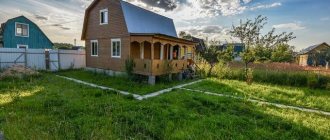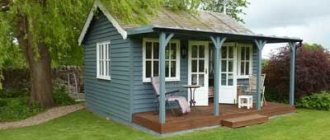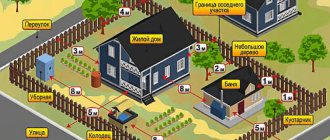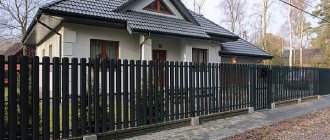All lands located on the territory of the Russian Federation are divided into certain categories. Each territory has its own purpose. This prohibits its use for other purposes.
Dear readers! The article talks about typical ways to resolve legal issues, but each case is individual. If you want to find out how to solve your particular problem , contact a consultant:
+7 (499) 938-81-90 (Moscow)
+7 (812) 467-32-77 (Saint Petersburg)
8 (800) 301-79-36 (Regions)
APPLICATIONS AND CALLS ARE ACCEPTED 24/7 and 7 days a week.
It's fast and FREE !
One of the types of designated areas includes territories of settlements allocated for individual housing construction.
In 2021, the Law on Dacha Amnesty is still in force, allowing the construction of housing on such sites in a simplified manner, without obtaining a construction permit. In addition, a simplified procedure for registering property rights applies to such buildings.
There are requirements that apply to buildings on individual housing construction territories. In such areas, only low-rise construction is permitted. However, recently the construction of apartment buildings on individual housing construction has become very popular, which is prohibited by law.
Purpose of the site
Individual housing construction lands are provided to citizens for:
- gardening and gardening;
- construction of a low-rise building;
- farming.
In such areas it is allowed to build real estate intended for single-family residence. Residential buildings must have no more than 3 floors and one entrance/exit. It is allowed to install attics. The area of the object should not exceed 1.5 thousand square meters. m.
The legislative framework
In accordance with Article 42 of the Land Code of the Russian Federation, owners of plots must use them for their intended purpose and only in permitted ways.
The requirements for houses that are allowed to be built on individual housing construction sites are placed in Part 3 of Art. 48 Civil Code of the Russian Federation.
In Art. 222 clauses 1, 2 of the Civil Code of the Russian Federation states that any objects built without taking into account the type of permitted use can be considered unauthorized buildings and subject to demolition at the expense of the developers who erected them.
In accordance with the requirements of the current civil legislation, ownership, use and disposal of property in shared ownership are carried out by agreement of all its participants. This requirement encourages owners of individual residential buildings to allocate “in kind”, “divide” their residential buildings, that is, to formalize their rights to separate residential premises.
According to Part 7 of Art. 41 of the Federal Law of July 13, 2015 No. 218-FZ “On State Registration of Real Estate” (hereinafter referred to as Law No. 218-FZ) state cadastral registration and state registration of ownership of premises or premises (including residential) in a residential building (individual property) housing construction) or in a garden house are not allowed.
In this case, two options are possible: an individual residential building must be converted either into an apartment building with the simultaneous creation of apartments in it, or into a residential building of a blocked building with the simultaneous formation of blocks in it. These objects have different legal regimes, which owners should take into account when making decisions.
According to current legislation, an apartment building is a collection of two or more apartments that have independent access either to a land plot adjacent to a residential building or to common areas in such a building; An apartment is a structurally separate room in an apartment building.
At the same time, the land plot on which the apartment building and other real estate objects included in such a building are located is the common shared property of the owners of the premises in the apartment building.
To carry out state cadastral registration and state registration of ownership of apartments, it is necessary to change the purpose of the building from “residential” (residential building) to “apartment building” and on the basis of clause 4, part 5, art. 14 of Law No. 218-FZ to carry out state cadastral registration simultaneously in relation to all apartments in such a building.
If reconstruction is required to change the purpose of a building and create premises in it, the state cadastral registration of changes in such a building and the state cadastral registration of the premises located in it are carried out on the basis of an application from all co-owners of the specified property with the attachment of permission to put the reconstructed property into operation, and also the technical plan of the building, containing the information necessary for the state cadastral registration of the specified premises.
If reconstruction is not required to change the purpose of the building and create premises in it, information about the purpose of the building can be changed on the basis of an application from all co-owners of the specified property with the attachment of an act of a state authority or local government on changing the purpose of the building from “residential building” for an “apartment building” without reconstruction.
Based on Part 5 of Art. 41 of Law No. 218-FZ, after state registration of apartments in a building, all participants in common shared ownership of the specified building must apply for state registration of ownership of the premises belonging to them, attaching an agreement concluded between the co-owners of the building, which will determine the ownership of the apartments, and with statements about the termination of their right to a share in the ownership of this building.
Blocked residential buildings are understood to mean residential buildings with no more than three floors, consisting of several blocks, the number of which does not exceed ten and each of which is intended for one family, has a common wall (common walls) without openings with the adjacent block or neighboring ones blocks, located on a separate plot of land and has access to public territory.
Law No. 218-FZ does not provide for the entry into the Unified State Register of Real Estate of information about residential buildings of blocked development, as well as the registration of rights to such houses; each block is an independent piece of real estate, in respect of which state cadastral registration and state registration of rights are carried out.
At the same time, the legal regime of residential buildings of blocked development, in contrast to the legal regime of apartment buildings, involves the formation of a separate land plot under each block, which is preferable for its use by the owner.
Taking into account the fact that the formation of capital construction projects in this case is carried out as a result of the division of the property, in accordance with Part 1 of Art. 41 of Law No. 218-FZ, state cadastral registration and state registration of rights to the resulting real estate objects are carried out simultaneously.
If the division of a building and the formation of blocks in a block building requires reconstruction of the building, state cadastral registration and state registration of rights to the blocks formed as a result of the division are carried out on the basis of an application from all co-owners of the specified property with the attachment of an agreement on the division of the property or a corresponding court decision , permission to put the reconstructed property into operation, as well as a technical plan of the building containing the information necessary for the state cadastral registration of the specified blocks.
If the building initially corresponded to the characteristics of a residential building of a blocked development and reconstruction for its division is not required, registration with the state cadastral register and state registration of rights to the formed blocks is carried out on the basis of an application from all co-owners of the specified property with the attachment of an agreement on the division of the property or a corresponding decision court, as well as a technical plan, in the annex to which, as a justification for cadastral work, it is necessary to include the conclusion of the body authorized in the field of urban planning activities, containing information confirming that the original (converted) building corresponds to the characteristics of a residential building of a blocked development without the need for reconstruction.
If there is a disagreement on the issues of state cadastral registration and state registration of rights to apartments, blocks in a block building, the co-owner of the building has the right to apply to the court in a claim proceeding to the other co-owners of the said building with demands for state cadastral registration of premises, recognition of rights to them and termination of the right of common ownership for this building.
At the same time, in accordance with Art. 42 of the Land Code of the Russian Federation, owners of land plots and persons who are not owners of land plots are obliged to use land plots in accordance with their intended purpose in ways that should not harm the environment, including the land as a natural object. In this regard, changing the purpose of a building from “residential” to “apartment building” and dividing a residential building into blocks require bringing into compliance the type of permitted use of the land plots on which such real estate is located.
Apartment building on individual housing construction
Unscrupulous developers are building apartment buildings on individual housing construction sites in order to make a profit. However, at the same time, they grossly ignore the requirements of the law, which is an offense.
Some individuals disguise the constructed apartment buildings as individual housing or townhouses. Some citizens even manage to register ownership of such objects. However, this right can be challenged at any time in court by a claim from an interested party.
The court will order an examination, during which the essence of the building will be determined. In this case, the developer will be pointed out that the building does not comply with the type of permitted use and will be obliged to demolish the building.
In practice, the initiators of legal proceedings are most often neighbors who are disturbed by noise from a nearby house. In addition, if several families live in a building, spontaneous parking for residents’ cars will most likely be organized in the adjacent area. Narrow private streets are more likely to be unsuitable for so many cars.
However, a situation may arise that the developer will have friendly relations with neighbors and the administration of the locality. In this case, another problem may arise regarding connection to utility networks.
The power, which is indicated in the technical conditions for connecting the facility to the networks, is usually enough for 1 family.
This is not enough to support an apartment building designed for several families. In such housing located on an individual housing construction site, there may be regular problems with power supply that arise due to overloads in the electrical network. This situation can make it difficult to live comfortably in housing.
Find out how to lease land for individual housing construction. What documents are needed when purchasing a plot of individual housing construction? The list is here.
Is it possible to build?
So, is it possible to build an apartment building using individual housing construction? The answer to this question is unequivocal - it is impossible.
What can conscientious developers who did not take into account the category of land during construction, or citizens who really want to build an apartment building on such territory, do?
There are 2 options:
- Try to change the type of permitted use of the territory. To do this, you need to collect a package of documents and submit a corresponding application to the local administration.
- Designate the constructed facility as an isolated premises, and not as multi-apartment housing. However, judging by current practice, this will be extremely difficult to do.
What is allowed to be built
The main document regulating construction work on individual housing construction lands is the Town Planning Code. The safety of buildings also depends on strict compliance with the standards prescribed in SNiPs.
General rules to follow when planning construction work:
- Drawing up a site planning diagram.
- Obtaining permission to conduct construction work.
When allocating a plot of land, it is recommended to fix its boundaries with stakes.
When placing the building, adhere to the following distances :
- from the road to the future foundation of the building - 5 m;
- from travel to other territories to the construction site - at least 3 m.
- from the house to the border of the future fence - no closer than 3 m.
- from outbuildings to the fence - at least 1 m.
Maintaining the red line is a guarantee of the legality of the placement of construction projects , protection from litigation with neighbors and local governments.
Let's take a closer look at what can be built on a land plot allocated for individual housing construction.
House
The following parameters of a residential building are established by law, which must be applied during its construction on individual housing construction lands:
- Low-rise - the number of floors is no more than three.
- The area of the building is no more than 1500 m2.
- Placement of construction projects up to the “red line”.
To be able to construct ancillary buildings, the size of the allocated land plot must exceed 12 acres.
The fire safety regime dictates the following rules:
- Wooden houses are located at a distance of at least 15 m from the neighboring residential building.
- The interval between stone buildings can be from 6 m.
- The distance from the house to the outbuildings is more than 4 m.
- Location of the gas tank storage location outside the house.
- Use of electrical wiring coated with protective material.
The internal structure of a residential building must meet the following parameters:
- Ceiling height – 2.5 m.
- Living room area – from 12 m2.
- The size of the bedroom is from 8 m2.
- The total area of the bathroom is from 2.7 m2.
The height of the fence is regulated by law : 2.5 m - side facing the street, 1.5 m - demarcation from neighboring areas.
Garage
The construction of a garage on individual housing construction lands, in addition to compliance with construction and fire safety measures, requires strict compliance with sanitary legislation .
This is explained by the fact that parking places for vehicles are subject to negative impacts on the environment and human health.
Existing building codes for the construction of garages are advisory in nature.
This position of legislators allows owners of objects built in violation of established requirements not to fear being brought to criminal and administrative liability.
The exception is a proven threat of harm to human life and health, as well as the environment.
Legal requirements for garage construction:
- The placement of the structure with a gate facing the street should ensure the free movement of pedestrians .
- The distance from the construction site to the wall of the neighboring house is at least 6 m.
- The interval from your residential building to the garage is at least 3 m.
- The distance from the fence to the garage is at least 1 m.
- The distance of the garage from the nearest edge of the road is at least 3-5 m.
All intervals are calculated from the edge of the most protruding part of the garage building - the base or roof slope.
All of the above requirements apply to garages placed on a foundation . Temporary portable structures are not firmly tied to their location, so their placement is governed solely by common sense.
If it is impossible to comply with SNiP standards during the construction of a garage, coordinate the location of the facility with the owners of neighboring plots. Confirm your agreement with your neighbors on the site of future construction with a signed document drawn up in any form.
The dimensions of a garage building are not regulated by building codes and regulations , therefore, the size of the car is taken as an indicator to be guided by when determining the area of the future building.
It is prohibited to use a garage building erected on individual housing construction lands for commercial purposes.
Bath
When constructing a bathhouse or sauna on a site for individual housing construction, urban planning and sanitary legislation requires compliance with the following rules :
- distance from the demarcation line with the neighboring site - from 3 m;
- distance to the nearest residential building – 5 m;
- location of the facility with orientation to the wind rose to prevent smoke from neighboring residential buildings;
- erection of a building on a hill, in the case of construction work in a region with heavy rainfall.
It’s good if the bathhouse can be viewed from the windows of the house - in case of a fire, you can quickly detect it.
The fire safety requirement to place a bathhouse or sauna in close proximity to a reservoir - if it borders on an individual housing construction site - is controversial in the opinion of sanitary control authorities.
Maintaining a distance of 20 meters will prevent wastewater from entering river beds.
This applies not only to natural reservoirs, but also to drinking water wells.
From the point of view of safe operation of the bathhouse, it would be preferable to use larch as a material for walls .
Anti-fire treatment of structural elements is encouraged.
Greenhouse and greenhouse
Devices for growing vegetable crops in protected soil are another type of buildings allowed for placement on an individual housing construction site. SNiP recommends placing the structure no closer than 1 meter from the boundary .
The optimal option for placing greenhouses and greenhouses satisfies the following conditions:
- quality soil;
- no shading from trees;
- use of natural windbreaks;
- absence of a wind tunnel effect in the proposed construction area.
Well
Drilling a well must be preceded by geological surveys . Before starting work, it is necessary to calculate future water consumption and record it in the information database of the relevant structures.
Obtaining permission from Rospotrebnadzor and agreeing on the possibility of carrying out work with neighbors is the next necessary stage.
The rules for placing wells on an individual housing construction site are legally established:
- Availability of a site development plan.
- Distance from a residential building at a distance of at least 5 m.
- The distance to the septic tank is over 25 m.
- Lack of green spaces within a radius of 10 m.
It is prohibited to drill wells in the immediate vicinity of the roadway, as well as in the basements of residential buildings.
Barn
For outbuildings on individual housing construction lands, places are chosen that are unsuitable for placing other objects, as well as setting up a vegetable garden and flower garden.
The shed is used for seasonal or permanent tools and equipment necessary for repairing and maintaining the house and site.
It can be either standing on a foundation or easily dismountable.
The law recommends maintaining the following distances to the border with the neighboring property :
- 1 m. – a room intended for storing household equipment;
- 4 m. – a barn used for raising farm animals.
The place for raising livestock must be located at a distance of more than 12 m from a neighboring residential building.
Canopy
Sheds placed on individual housing construction lands belong to the category of temporary structures equated to outbuildings.
Regardless of what purpose you plan to use the canopy for, it should be placed no closer than 1 meter from your neighbors’ property . Another condition is the direction of the roof slope towards your site.
Veranda
A veranda is a room attached or built into a permanent structure. Its external walls become an extension of the house, a reference point for measuring control distances.
Adding a veranda is unacceptable if the wall of the house was initially located at the minimum possible distance from the boundaries of the neighboring plot.
Alcove
When building a gazebo, the following rules apply:
- for a capital facility, the distance to the fence of a neighboring household is 3 m;
- for a temporary structure, the distance from the fence is 1 m.
Toilet and cesspool
Placing a toilet on individual housing construction lands is possible provided that a distance from the neighbor’s fence is maintained at least 1 m .
When determining the exact distance, the location of drinking water sources is taken into account - according to the requirements of sanitary legislation, distancing is required at a distance of no closer than 12 m.
The cesspool is located at a distance of at least 50 m from the water supply source , and from 1 to 3 m from the border of the neighboring plot.
What else is allowed
The type of permitted use of individual housing construction, in addition to construction work, allows you to engage in gardening, landscaping, and planting green spaces on the site.
There are rules governing the planting of trees and shrubs on land allocated for individual housing construction:
- the distance from the bush to the border of the neighboring plot is at least 1 m;
- the interval between the fence and low trees is 2 m;
- planting tall trees is allowed at a distance of more than 4 m from the boundary.
Consequences of construction without permission
The consequences of the construction of multi-apartment buildings on individual housing construction sites threaten both unscrupulous developers and citizens who purchased such housing.
Consequences for the developer:
- administrative fine in the amount of 40-50 thousand rubles;
- recognition of the object as an unauthorized construction and forcing the developer to demolish it or demolish the building at his expense.
The authorities are currently considering a bill to tighten penalties for such construction.
It is expected that developers will subsequently be subject to a fine of 1-5 million rubles or suspension of activities for up to 90 days. Malicious violators will face both types of punishment.
Consequences for buyers of apartments in houses on individual housing construction plots:
- financial losses;
- deprivation of housing;
- forcing the demolition of a building.
Citizens remain the deceived party. They only have the right to demand that the developer return funds and pay compensation. However, in most cases, unscrupulous developers do not have sufficient funds in their accounts to compensate citizens. Therefore, even going to court may not lead to the desired result.
Citizens can only be vigilant and before purchasing an apartment in an apartment building, inquire about the category of land on which the object is built.
Read how to register land for individual housing construction. Is it possible to build a hotel on an individual housing construction site? Information here.
Do they pay tax on individual housing construction? Details in this article.
How to avoid scammers?
There are several recommendations for citizens who are planning to purchase apartments at an attractive price.
How to avoid fraud:
- It is necessary to request documentation from the developer. The main papers are a certificate of state registration of ownership, an extract from the Unified State Register, a cadastral passport, projects and plans. By comparing the documents, you can see the permitted use and purpose of the land.
- It is necessary to check that the construction permit indicates “apartment building” or “low-rise building” and not “individual residential building”. The documentation must also indicate the area of the object and its number of floors, as well as the area of the land plot.
- It's worth getting to know those. conditions for connecting the facility to utilities.
- It is worth comparing the information contained in the construction permit with the design documentation.
- It is recommended to clarify with the developer the procedure in which the registration of rights to the constructed object will be carried out. A simplified procedure is possible only in relation to individual housing construction, garden and country houses.
- It is worth assessing the content of the contract that the developer proposes to conclude. This must be a paper on equity participation. Such an agreement must be subject to mandatory registration with Rosreestr. This eliminates the possibility of double selling.
It is recommended to consult with a legal specialist if there is the slightest doubt about the transparency of the transaction. This measure will help avoid future litigation and financial deprivation.
New concept: individual housing construction object (individual residential building)
Different laws use 3 concepts:
- Individual housing construction project,
- House,
- Individual residential building.
In this regard, various questions and discrepancies arose.
New changes to the Town Planning Code of the Russian Federation removed these changes and established that individual housing construction, individual railways and simply a “residential building” are one and the same .
The same changes introduced the concept of “individual housing construction object”.
An individual housing construction project (also known as residential housing) is:
- detached building,
- number of above-ground floors – no more than 3,
- height no more than 20 meters,
- consists of rooms and premises for auxiliary use,
- these rooms and premises are intended to satisfy citizens’ household and other needs related to their residence in such a building,
- the building is not intended not intended to be divided into independent real estate units.
As for the last point, it means that the house cannot be divided into apartments. A residential building is a single building indivisible into separate objects.










